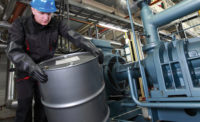A strategy to reduce hazards and defects, cut costs, and improve efficiency and communications is to implement the Japanese 5S methodology. 5S also aims to eliminate the “seven deadly wastes”: overproduction, unnecessary transportation, excess inventory, defects, overprocessing, time wasted while waiting, and wasted employee motions and movement. 5S rests on five “pillars”: 1) seiri, or sort; 2) seiton, or set in order or systematize; 3) seiso, or sweep or shine; 4) seiketsu, or standardize; and 5) shitsuke, or self-discipline or sustain.
Before you decide to implement 5S
To start, it’s wise not to call 5S a “program.” Programs have beginnings and endings. Employees have seen many programs come and go, and they can be perceived as “flavors of the month” or fads. 5S is anything but a fad. It also should not be presented to your workforce as simply an amped-up housekeeping effort. 5S is not reserved for janitors and cleaning crews. It’s not about pushing brooms. It’s also not a list of rules handed down by top management with no input from the workforce. And it’s not a subject that can be taught to your employees in a single classroom training session.
Start with a pilot project
Target an “island of excellence”—one department, one work process, one location in your facility. Form an implementation team to conduct a needs assessment for the pilot target; evaluate the work environment, work conditions and work flow; observe current work behaviors, and survey workers about their attitudes and beliefs regarding their jobs.
This homework and research will determine: 1) what kind of and how much employee education is needed; 2) how best to communicate the introduction of 5S through signage, posters, message boards, newsletters, internal emails, and social media; 3) goals for 5S improvements (waste reduction, defects reduction, safety improvements, etc.); 4) how to track progress and give feedback toward attaining those goals through visual communications—scoreboards, messaging, calendars; and 5) how to celebrate—recognize and reward—5S achievements.
5S is a five-step process. Each step must be completed before moving on to the next step. Keep in mind that these steps can be implemented on a factory floor, in an office, on a loading dock, in a warehouse—5S is not limited to manufacturing operations.
Step 1 – Sort
After your 5S pilot team has done its homework, audited, conducted training, etc., for the first targeted location, Step 1 is Sort. Criteria are set for removing—by red-tagging—all tools, materials, equipment, etc. not needed to get a job done. How frequently a tool or any other item is used for a job determines where it will be placed or located. When red-tagging, ask:
• Is this item needed?
• If it is needed, is it needed in this quantity?
• If it is needed, how frequently is it used?
• If it is needed, where should it be located?
Items used hour by hour or day by day should be kept within arm’s reach of the point of use. Items or equipment used once a week or once a month should be kept within the work area. Less frequently used items should be stored in a more distant location. Unneeded or obsolete items should be stored in a designated holding area.
Step 2 – Systematize or Set in Order
Workers at this point conduct an honest needs assessment. What do I need to do my job? Where should I locate each item I need? How many of each item do I really need? Shadow boards can be set up within easy reach of workstations, with the silhouette or “shadow” of the shape of each frequently used item outlined for organized placement and easy, quick access. List and prominently post for the information of every employee where items are to be found. Employees must know where to quickly find every item. Label storage lockers, cabinets, drawers, cupboards, etc. so employees know what content is contained within.
Map out the work flow and floor plan of the area showing where everything is “set in order.” Mark aisleways and workstation boundaries. Show the position of equipment. Tiger marks indicate high-hazard safety zones Take before and after photos/videos and display prominently.
Step 3 – Sweep or Shine
This is the point in the 5S process where daily cleaning becomes a habit. The work space is cleaned before starting the job and before closing down the job. Ten or 15 minutes should be set aside daily for sweep and shine activity. Use this daily cleaning routine to inspect the work space and equipment for defects.
Logs should be displayed prominently to build the 5S essentials of employee ownership and accountability for sweeping, shining, and finding and fixing problems. Also to be prominently displayed are owner check sheets positioned near where each employee works. These check sheets list job tasks that require daily or weekly maintenance and cleaning, with “owners” of the tasks checking off each item as it is completed every day or week.
Step 4 – Standardize
Cultural values and beliefs —“the way things are done around here”— are the bedrock of 5S norms of behavior. Routines and standard operating procedures need to be established and communicated in order for the first three steps of 5S to be regularly repeated.
Also to be standardized at this time are all red-tagging procedures, shadow boards, position lines, and the labeling of all items and storage containers and holding areas. Cleaning schedules are standardized using the 5S owner check sheets. Single-point lesson plans or instructions are posted and visibly prominent to document and communicate 5S procedures for steps 1, 2 and 3 for each workstation or work space. The individuals responsible for following these lessons and carrying out these instructions are identified for accountability.
5S inspection teams, consisting of employees, supervisors, upper management, plant engineers, safety managers, and maintenance personnel regularly audit and evaluate the execution of the first three steps of 5S to ensure standardization.
Step 5 - Self-discipline or Sustain
It takes self-discipline on the part of everyone in your organization to sustain 5S and achieve its many benefits. Visual communications—message boards, storytelling boards, scoreboards, signs, banners, posters, etc.—are critical to sustaining self-discipline.
5S implementation never reaches an end point—a point where you can say, “OK, we’re done with 5S.” Once you cycle through the five steps, go back and repeatedly check on activities relating to each of the steps.


